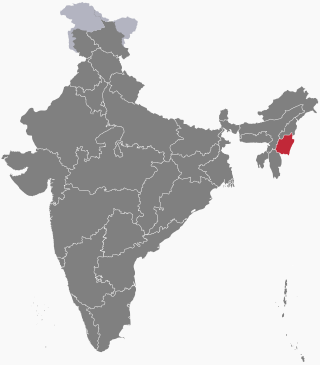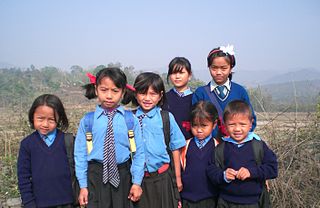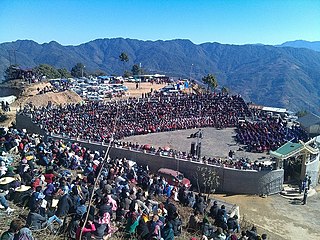
Assam is a state in northeastern India, south of the eastern Himalayas along the Brahmaputra and Barak River valleys. Assam covers an area of 78,438 km2 (30,285 sq mi). It is the second largest state in northeastern India by area and the largest in terms of population, with more than 31 million inhabitants. The state is bordered by Bhutan and Arunachal Pradesh to the north; Nagaland and Manipur to the east; Meghalaya, Tripura, Mizoram and Bangladesh to the south; and West Bengal to the west via the Siliguri Corridor, a 22-kilometre-wide (14 mi) strip of land that connects the state to the rest of India. Assamese and Bodo are two of the official languages for the entire state and Meitei (Manipuri) is recognised as an additional official language in three districts of Barak Valley and Hojai district. in Hojai district and for the Barak valley region, alongside Bengali, which is also an official language in the Barak Valley.

Nagaland is a state in the north-eastern region of India. It is bordered by the Indian states of Arunachal Pradesh to the north, Assam to the west, Manipur to the south, and the Naga Self-Administered Zone of the Sagaing Region of Myanmar (Burma) to the east. Its capital city is Kohima and its largest city is the twin Chümoukedima–Dimapur. The state has an area of 16,579 square kilometres (6,401 sq mi) with a population of 1,980,602 as per the 2011 Census of India, making it one of the least populated states in India.

The United Liberation Front of Asom (ULFA) is an armed separatist militant organisation operating in the Northeast Indian state of Assam. It seeks to establish an independent sovereign nation state of Assam for the indigenous Assamese people through an armed struggle in the Assam conflict. The Government of India banned the organisation in 1990 citing it as a terrorist organisation, while the United States Department of State lists it under "other groups of concern".

The Insurgency in Northeast India involves multiple separatist and jihadist militant groups operating in some of India's northeastern states, which are connected to the rest of India by the Siliguri Corridor, a strip of land as narrow as 14.29 miles (23.00 km) wide.

Golaghat district (Pron:ˌgəʊləˈgɑ:t) is an administrative district in the state of Assam in India. It attained district status in 1987. The district headquarters are located at Golaghat. The district occupies an area of3,502 km2 (1,352 sq mi) and lies 100 metres (330 ft) above sea level.

Terrorism in India, according to the Home Ministry, poses a significant threat to the people of India. Compared to other countries, India faces a wide range of terror groups. Terrorism found in India includes Islamist terrorism, ultranationalist terrorism, and left-wing terrorism. India is one of the countries most impacted by terrorism.

The Naga conflict, also known as the Naga Insurgency, is an ongoing conflict fought between the ethnic Nagas and the Government of India in North-East India. Nagaland, inhabited by the Nagas, is located at the tri-junction border of India on the West and South, north and Myanmar on the East.
Nagamese is an Assamese-lexified creole language. Depending on location, it has also been described and classified as an "extended pidgin" or "pidgincreole". Spoken natively by an estimated 4 million people in the Indian northeastern state of Nagaland, it developed primarily as a means of marketplace and trade communication. Despite the official language of the state being English, Nagamese functions as a lingua franca and is spoken by nearly all Nagaland inhabitants. It is also used in mass media as well as in official state-regulated domains, including news and radio stations, education and political and governmental spheres. Nagamese is classified as a creole as, despite it being spoken as an "extended pidgin" by the majority of speakers across Nagaland, it is also spoken as the native mother tongue of the Dimasa community in Nagaland's largest city, Dimapur.

The Barak Valley is the southernmost region and administrative division of the Indian state of Assam. It is named after the Barak river. The Barak valley consists of three administrative districts of Assam namely - Cachar, Karimganj, and Hailakandi. The main and largest city is Silchar, which seats the headquarter of Cachar district and also serves as administrative divisional office of Barak valley division. The valley is bordered by Mizoram and Tripura to the south, Bangladesh and Meghalaya to the west and Manipur to the east respectively. Once North Cachar Hills was a part of Cachar district which became a subdivision in 1951 and eventually a separate district. On 1 July 1983, Karimganj district was curved out from the eponymous subdivision of Cachar district. In 1989 the subdivision of Hailakandi was upgraded into Hailakandi district.
Dima Halam Daogah was an Indian extremist group operating mainly in Assam and Nagaland. The group laid down their arms in January 2013, and claimed to represent the Dimasa and their goal to create a Dimaland or Dimaraji in the two states.
Secession in India typically refers to state secession, which is the withdrawal of one or more states from the Republic of India. Whereas, some have wanted a separate state, union territory or an autonomous administrative division within India. Many separatist movements exist with thousands of members, however, some have low local support and high voter participation in democratic elections. However, at the same time, demanding separate statehood within under the administration of Indian union from an existing state can lead to criminal charges under secession law in India. India is described as a ‘Union of States’ in Article 1 of the Indian constitution I.e "Indestructible nation of destructible states" by its father of constitution Dr. Bhimrao Ramji Ambedkar where a state or Union territory of India cannot secede from India by any means and the Central Government has more powers than the respective state governments and can forcefully change the names and boundaries of the states without their permission at any time when needed for self interest and for the maintenance of integrity.

The Insurgency in Manipur is an ongoing armed conflict between India and a number of separatist rebel groups, taking place in the state of Manipur. The Insurgency in Manipur is part of the wider Insurgency in Northeast India; it displays elements of a national liberation war as well as an ethnic conflict.

The hill tribes of Northeast India are hill people, mostly classified as Scheduled Tribes (STs), who live in the Northeast India region. This region has the largest proportion of scheduled tribes in the country.

Border disputes of Northeast India mainly include inter-state conflict between Assam–Mizoram, Assam–Arunachal Pradesh, Assam–Nagaland and Assam–Meghalaya. The disputes, including clashes between rival police forces, have resulted in the loss of life, livelihood and property. The border disputes in some cases are part of the larger national (separatist), sub-regional and ethnic conflicts, as well as criminal enterprise fuelled. This internal land conflict in the districts of the northeast are part of the 322 districts affected by ongoing land conflicts out of a total of 703 districts in India.
In the state of Manipur in northeast India, conflict arose between the Kukis and Nagas soon after India's independence. The Nagas, who dominated the northern hill regions of the state, attempted to homogenise the area in order to demand integration with the Naga Hills region further north. This caused displacement of Kukis to the southern districts as well as the central hill regions during the 1950s. Major clashes again occurred during 1992-98, leading to the deaths of more than 1,000 people and diplacement of 50,000–100,000 people.

Northeast India, the easternmost region of India, refers to the states of Arunachal Pradesh, Assam, Manipur, Meghalaya, Mizoram, Nagaland, Tripura, and Sikkim. This region holds significance due to its unique political, cultural, and strategic characteristics. It is encircled by five international borders, sharing boundaries with Bhutan, China, Myanmar, Bangladesh, and Nepal, making it crucial in India's geopolitical landscape. The region accounts for 4 percent of the total surface of India and has a population of over 45 million. The region is connected to the rest of India by a 30 km wide passage known as the ‘Chicken’s Neck’.
The 2011 Tirap Ambush was a violent clash within the National Socialist Council of Nagaland (NSCN) between the NSCN--Isak Muivah (NSCN-IM) and the NSCN--Khaplang (NSCN-K) militant groups on the Indo-Myanmar border of Tirap district, in Eastern Arunachal Pradesh, India.

The siege of Mukalimi was an armed conflict that occurred from 26 December – 30 December 2013, in the Mukalimi area of Nagaland, India. The siege resulted from escalating tensions following an incident on 21 December 2013, when two Sumi women were allegedly strip-searched by NSCN-IM cadres at a checkpoint.
The Kuki-Karbi conflict is an ethnic conflict between the Kuki people and Karbi people in the Karbi Anglong district of Assam, India. The conflict has its roots in disputes over land, resources and political representation between the two groups.

Throughout the long-running separatist insurgencies in Northeast India, dozens of India-based insurgent groups have been involved in the neighboring conflict in Myanmar, both sheltering in Myanmar from the counterinsurgent Assam Rifles and participating in the conflict itself. Outside of several Indian-led operations, including Operation Golden Bird in 1995, Operation Hot Pursuit in 2015, or Operation Sunrise I and II in 2019, areas in which these insurgent groups are active have scarcely experienced fighting. Amid the escalation of civil war in Myanmar from 2021, several sources claim that the majority of Indian ethnic armed organisations (IEAOs) are allied, or have some level of understanding, with the ruling military junta of Myanmar, who allows them to maintain bases inside mountainous areas of northern Myanmar, typically in return for the IEAOs attacking anti-junta resistance groups.













